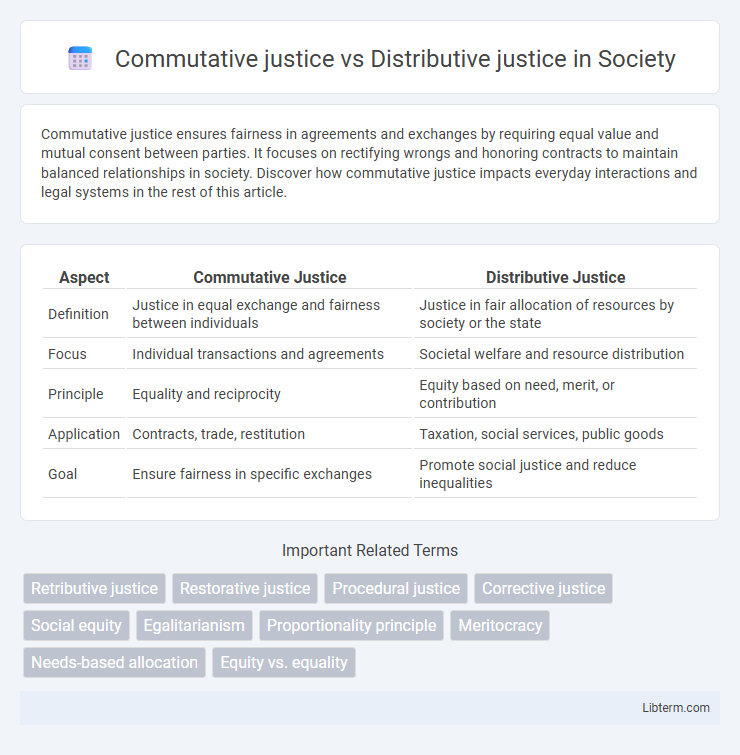Commutative justice ensures fairness in agreements and exchanges by requiring equal value and mutual consent between parties. It focuses on rectifying wrongs and honoring contracts to maintain balanced relationships in society. Discover how commutative justice impacts everyday interactions and legal systems in the rest of this article.
Table of Comparison
| Aspect | Commutative Justice | Distributive Justice |
|---|---|---|
| Definition | Justice in equal exchange and fairness between individuals | Justice in fair allocation of resources by society or the state |
| Focus | Individual transactions and agreements | Societal welfare and resource distribution |
| Principle | Equality and reciprocity | Equity based on need, merit, or contribution |
| Application | Contracts, trade, restitution | Taxation, social services, public goods |
| Goal | Ensure fairness in specific exchanges | Promote social justice and reduce inequalities |
Introduction to Commutative and Distributive Justice
Commutative justice governs fair exchanges and obligations between individuals, ensuring equality in voluntary transactions and restitution for wrongs. Distributive justice addresses the equitable allocation of resources and burdens within a society, guided by principles of fairness and social welfare. Together, these justice concepts form the foundation for legal and ethical frameworks balancing individual rights with collective responsibility.
Defining Commutative Justice
Commutative justice refers to the principle of fairness in exchanges and transactions between individuals, ensuring each party receives what is due without exploitation or fraud. It focuses on equality in voluntary agreements, contracts, and restitution, maintaining balance in private relationships. Distributive justice, by contrast, concerns the fair allocation of resources and benefits across society based on need, merit, or equality.
Understanding Distributive Justice
Distributive justice concerns the fair allocation of resources and wealth among individuals in a society, emphasizing equity based on need, contribution, or merit. It aims to address social inequalities by ensuring that benefits and burdens are distributed according to principles of fairness and social utility. Understanding distributive justice requires analyzing various frameworks like egalitarianism, meritocracy, and utilitarianism to determine the most just approach for resource distribution.
Historical Evolution of Justice Concepts
Commutative justice, rooted in ancient Greek philosophy, primarily addresses fairness in individual exchanges and contracts, emphasizing equality and reciprocity. Distributive justice, evolving through Aristotelian and later modern social theories, concerns the equitable allocation of resources and societal benefits based on merit, need, or contribution. Historical developments, including the transition from classical to modern political thought, expanded distributive justice to encompass broader social equity and welfare principles beyond mere transactional fairness.
Key Principles of Commutative Justice
Commutative justice centers on fairness in voluntary exchanges and equal value in transactions between individuals, emphasizing the principle of reciprocity. It requires that each party receives what is due, ensuring no party is harmed or unfairly enriched in contracts, sales, or compensation for damages. The key principles include equality, mutual consent, and restitution to restore balance when rights are violated.
Core Elements of Distributive Justice
Distributive justice centers on the equitable allocation of resources, benefits, and burdens across society, emphasizing fairness based on need, merit, or equality. Core elements include proportionality, where distribution corresponds to individuals' contributions or needs, and impartiality, ensuring no bias affects the allocation process. Unlike commutative justice, which governs fair exchanges between individuals, distributive justice addresses systemic fairness in social and economic structures.
Differences Between Commutative and Distributive Justice
Commutative justice focuses on fairness in exchanges and agreements between individuals, ensuring equality in voluntary transactions such as contracts and trade. Distributive justice, by contrast, concerns the equitable allocation of resources and benefits within a society, emphasizing the role of authority in achieving social balance. The key difference lies in commutative justice addressing proportional reciprocity among equals, while distributive justice manages the just distribution of goods based on need, merit, or contribution.
Applications in Legal and Social Systems
Commutative justice governs fair exchanges between individuals, ensuring contracts and transactions are honored within legal systems to maintain trust and prevent fraud. Distributive justice addresses the equitable allocation of resources and opportunities in society, guiding policies on taxation, welfare, and social services to reduce inequality. Both concepts underpin legal frameworks and social programs that balance individual rights with collective responsibilities for societal stability.
Challenges and Criticisms of Each Justice Type
Commutative justice faces challenges in ensuring fairness in voluntary exchanges, often criticized for overlooking broader social inequalities and power imbalances that affect consent and equity. Distributive justice is frequently critiqued for its subjective criteria in allocating resources, with debates surrounding the balance between equality, need, and merit, leading to disagreements on what constitutes a just distribution. Both justice types struggle to address the complexities of social context, economic disparity, and moral philosophy in creating universally accepted frameworks.
Conclusion: Balancing Justice in Modern Societies
Commutative justice ensures fairness in individual exchanges by emphasizing equality and honor in agreements, while distributive justice focuses on the equitable allocation of resources based on societal needs and contributions. Balancing these principles is crucial for modern societies to maintain social harmony and promote both individual rights and collective welfare. Effective legal and policy frameworks integrate both to address disparities and foster inclusive justice systems.
Commutative justice Infographic

 libterm.com
libterm.com